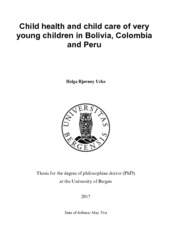| dc.contributor.author | Urke, Helga Bjørnøy | |
| dc.date.accessioned | 2017-08-04T06:36:39Z | |
| dc.date.available | 2017-08-04T06:36:39Z | |
| dc.date.issued | 2017-05-31 | |
| dc.identifier.isbn | 978-82-308-3057-4 | |
| dc.identifier.uri | https://hdl.handle.net/1956/16203 | |
| dc.description.abstract | With the global progress in reduction of child mortality, an increasing concern for the health, development and well-being of the surviving child has emerged. It is estimated that 250 million children are not reaching their developmental potential in developing countries, due to among others malnutrition, inadequate care and exposure to violence. In addition, structural and other social aspects of the immediate family and wider community environment of the child exert influence on the possibility of realization of unique developmental potential. The overall aim of this dissertation was, through various approaches, to assess variations in child health and child care by a range of social determinants at contextual and resource levels in the Latin American countries the Plurinational state of Bolivia, the Republic of Colombia and the Republic of Peru. The dissertation is based on three papers using selected Demographic and Health Survey (DHS) data collected in Bolivia in 2008 (Paper III), Colombia in 2010 (Paper II-III) and Peru in the period 1991-2011 (five surveys) (Paper I-III). The first paper was concerned with chronic malnutrition and overweight, two important markers of child health. The release of international child growth standards in 2006 called for updated trend estimates of child nutritional status. In addition, trend analyses that are sensitive to variations within a country are lacking. The aim of Paper I was to explore how prevalence of stunting and overweight, developed among children aged 0-59 months in Peru in the period 1991-2011. Over the study period, national trends in child stunting declined, whereas for overweight they were stable. Levels of stunting were highest in rural areas compared with urban, the Andean and Amazon compared with the Coastal region, among children of low-educated mothers compared with other education groups, and among children living in households in the poorest compared with higher wealth quintiles. The trend in male overweight rose in coastal areas and in the richest wealth quintile. Although child health and development are most often considered the ultimate outcomes of interest, determinants and the measurement of intermediary factors, e.g. the care a child receives, have been accentuated. The aims of Paper II were to explore the possibility of measuring nurturing child care comprehensively through an index, and assess to what extent maternal resource level factors are associated with overall child care in urban and rural contexts and for different age groups in Colombia. Higher levels of various maternal resources were significantly associated with higher levels of child care. Registration of the child in a development program, higher household wealth, higher maternal education and maternal decision latitude were generally significantly associated with better child care, but the effects varied depending on age and urban or rural place of residence. Maternal education and household wealth were most consistently associated with higher levels of care among older children and in the urban samples, whereas child registration in a child development program and maternal decision latitude were most consistently associated with better care in the rural samples. The role of social determinants for health is widely studied for adults, and increasingly also for children, and often with focus on socioeconomic status (SES). Family characteristics of psychosocial character also affect the child’s care environment. Theory and research suggest that aggression and conflict affect child health and development negatively. Research on the effect of intimate partner violence (IPV) on child physical health is however lacking, particularly in developing countries. The aim of Paper III was to explore to what extent maternal IPV was associated with child physical health in children aged 0-59 months in Bolivia, Colombia and Peru, when adjusting for appropriate child care practices and sociodemographic- and economic factors. Mothers who had experienced IPV ever (Peru) and in the past 12 months (Bolivia) had significantly higher odds for reporting illness signs the past 15 days for their children aged 0-59 months compared to mothers not having experienced IPV. No significant association between IPV and child illness signs was found in the sample from Colombia. Based on the findings, it can be concluded that generalizing estimates of child health and care provision from national to sub-group levels can be misleading. The socio-ecological approach to research on child care and health issues continues to be relevant. Through this study this approach facilitates the revelation of significant social and contextual differences in child care and child health. In this dissertation, the traditional social determinants, e.g. maternal education and household wealth, as well as less studied social factors, e.g. IPV, are generally associated with the child outcomes of interest. These findings imply that a combination of direct and indirect strategies to reduce negative consequences of social inequality on child care and child health can be fruitful. This dissertation with its focus on both child health and child care as outcomes contributes to, and expands the social determinants research on children. | en_US |
| dc.language.iso | eng | eng |
| dc.publisher | The University of Bergen | eng |
| dc.relation.haspart | Paper I: Urke, H.B., Mittelmark, M.B., & Valdivia, M. (2014). Trends in stunting and overweight in Peruvian pre-schoolers from 1991 to 2011: findings from the Demographic and Health Surveys, Public Health Nutrition, 17(11), 2407-2418. The article is available at: <a href="http://hdl.handle.net/1956/9005" target="blank"> http://hdl.handle.net/1956/9005</a> | eng |
| dc.relation.haspart | Paper II: Urke, H.B., Mittelmark, M.B., Matanda, D.J., & Amugsi, D. (2016). Nurturing Childcare Practices in Urban and Rural Settings: Findings from the Colombia 2010 Demographic and Health Survey. The article is not available in BORA. | eng |
| dc.relation.haspart | Paper III: Urke, H.B. & Mittelmark, M. (2015). Associations between intimate partner violence, childcare practices and infant health: findings from Demographic and Health Surveys in Bolivia, Colombia and Peru, BMC Public Health, 15:819. The article is available at: <a href="http://hdl.handle.net/1956/11416" target="blank"> http://hdl.handle.net/1956/11416</a> | eng |
| dc.title | Child health and child care of very young children in Bolivia, Colombia and Peru | eng |
| dc.type | Doctoral thesis | |
| dc.rights.holder | Copyright the author. All rights reserved | eng |
| dc.identifier.cristin | 1470938 | |

